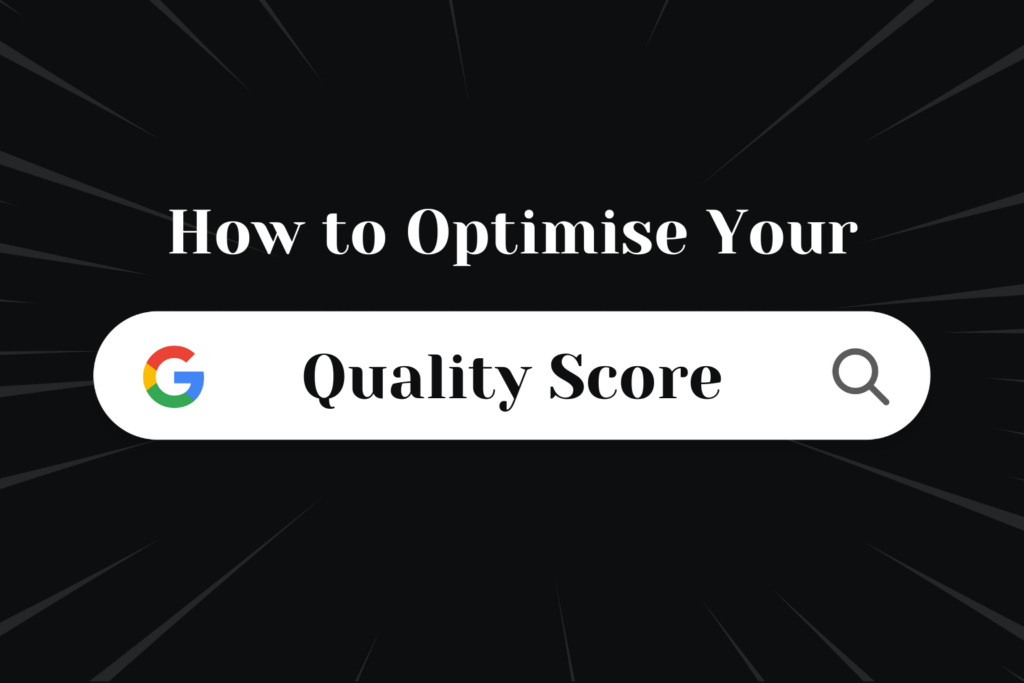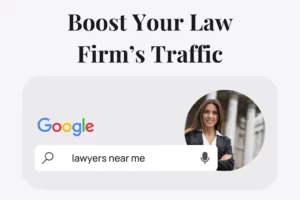Quality Score; A simple number that summerise your pre-click & post-click impression worthiness. In other words, it's a metric Google uses to decide whether or not it should show your ad and where that should be within the SERP. In this blog, we'll dive deep into explaining how to optimise the quality score of your ad account.
As Google Ads refine and change their algorithm, it’s essential for businesses to keep up with these changes and use every opportunity to maximise their Ads’ ROI (ROAS). According to Google, the quality score isn’t a KPI, and you shouldn’t optimise it the way you would with KPIs such as CPC, CPM and Impression share. However, if the quality score affects the impression rate so, why not try to improve it?
What is Quality Score, and why it matters?
Quality Score is a diagnostic tool that offers a snapshot of how your ads compete against your rivals. It plays a pivotal role in shaping key aspects of your campaign, from whether your ad makes it to the auction to how much you shell out per click and even the way your ad is showcased! Have you seen those nice ads with image extensions that steal the show?
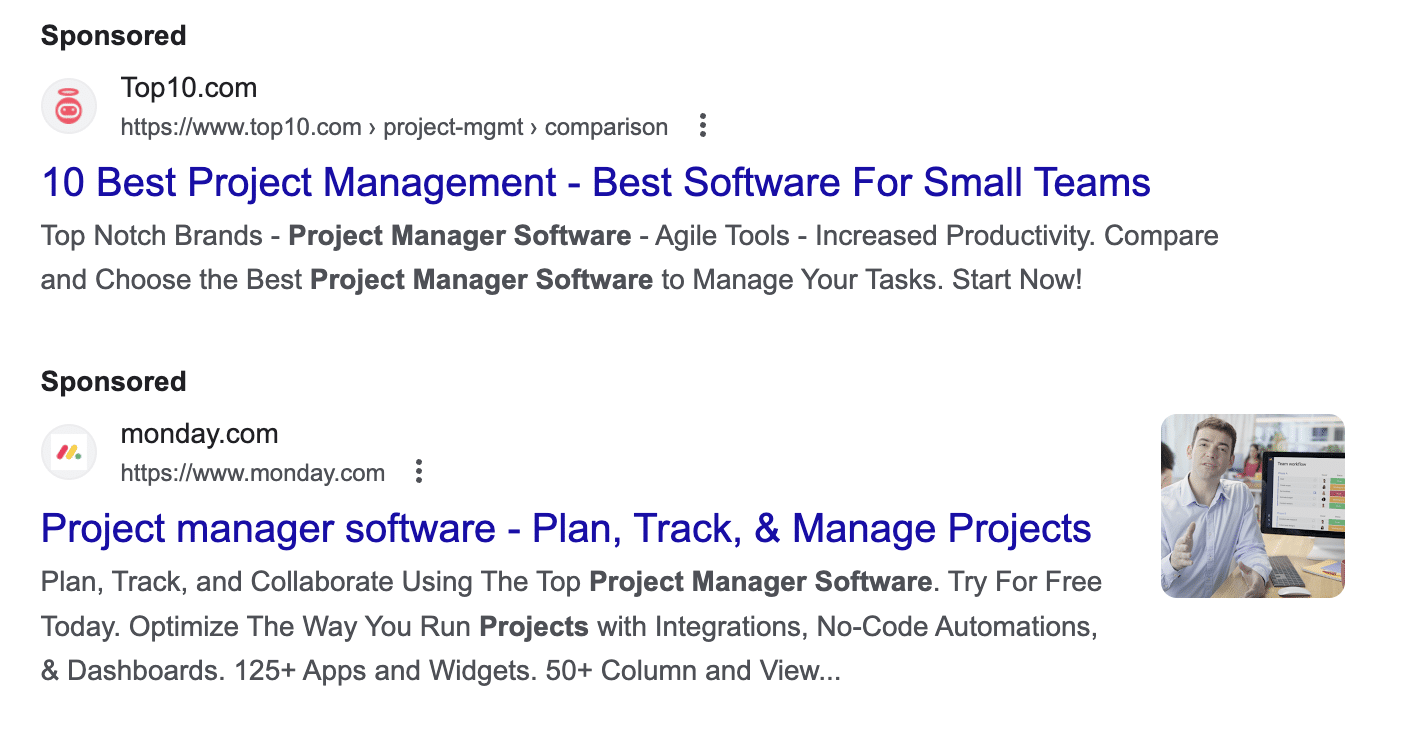
When your Quality Score improves, it's a clear sign that your ads got higher quality in the eyes of almighty Google, and this invariably propels your ad performance.
Google wants to serve good-quality ads that benefit you and tries to avoid and suppress low-quality ads for the sake of its own reputation. However, it's crucial not to become overzealous and put all your eggs in the Quality Score basket. Instead, see it as a barometer of the overall well-being of your ads.
How is the Quality Score calculated?
Now, you may ask, how does Google crunch the numbers to arrive at the Quality Score? It's the sum of three key components:
- Ad Relevance,
- Expected Click-Through Rate (CTR),
- And Landing Page Experience.
According to Adalysis, the quality score is calculated using the below-point system.
The formula for QS is :1 + Landing Page Experience Points + Ad Relevance Points + Click Through Rate Points. The table below shows a breakdown of each element and how many points they are worth. As you can see, Click Through, and Landing Page Experience have more points assigned to each level, meaning they are both more important and harder to fix.
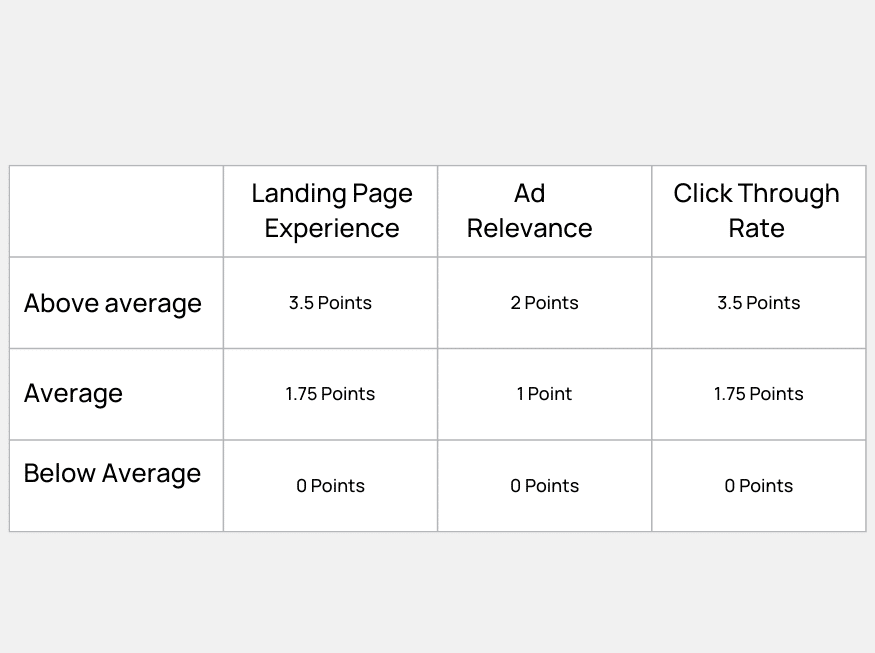
Now let’s unpack each of these elements:
Ad Relevance
This measure assesses how closely your ad aligns with the searcher's or visitor's intent. If, for example, the query is about “Assana Alternative”, then the ad needs to take into consideration what that would mean. As you can see in the below example, Monday.com nailed it and created an ad with all the right extensions to persuade the user to click on their ad.
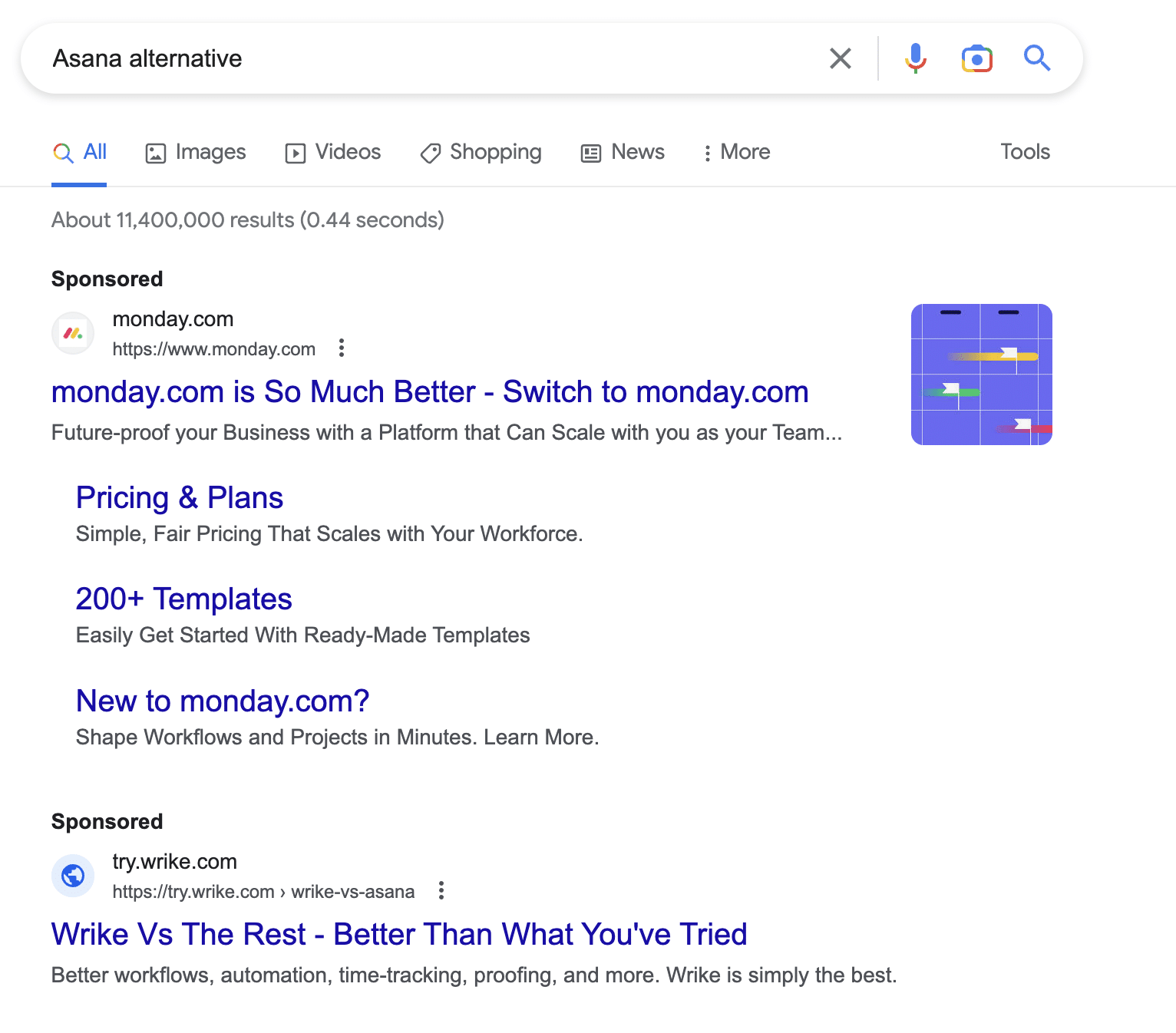
Expected CTR
This metric forecasts the chances of your ad getting clicked when shown in search results. The prediction is derived from your ads' previous performance. Essentially, it's a gauge of how appealing and pertinent your ad appears to the viewers.
The expected CTR is rated as 'above average', 'average', or 'below average'. Achieving an 'above-average rating indicates that your ad is expected to perform well based on past data. However, if your rating is 'average' or 'below average', it signals that there's room for improvement. This could involve tweaking the ad copy to make it more compelling or better aligning your ad with the specific keywords and user intent.
Keep in mind, an elevated expected CTR positively impacts your Quality Score, potentially leading to superior ad placements and reduced costs. Consequently, dedicating resources to improve your expected CTR can be a worthy investment.
Pro Tip: Ask yourself this question: Am I more likely to click on a known brand or a completely unknown one?" You can bolster the CTR of your search ads by running brand awareness campaigns on YouTube! While not directly linked, if someone has an interest in, say, project management software and they've seen your brand in a video ad, they're likely to click on your ad when they search for that product.
Landing Page Experience
Landing Page Experience is another vital element in the Quality Score equation. This metric evaluates how well your landing page meets the expectations of the user who clicked on your ad. It isn't just about the aesthetics of your page, but rather, it's about relevance, ease of navigation, and the overall value provided to the visitor.
Google assesses whether your landing page is related to your ad and keywords and whether it offers what the ad promises. Your page's user-friendliness is a key aspect evaluated by the platform. Its intuitive navigation, mobile compatibility, and swift load time all shape the user's journey. These factors, collectively, significantly influence your Landing Page Experience score.
An 'above-average rating in Landing Page Experience signifies that users find your page useful and relevant, leading to a better Quality Score. Improving this could involve making your page more relevant to your ad and keywords, improving the navigational structure, or speeding up the page load time. See our mobile page speed below!
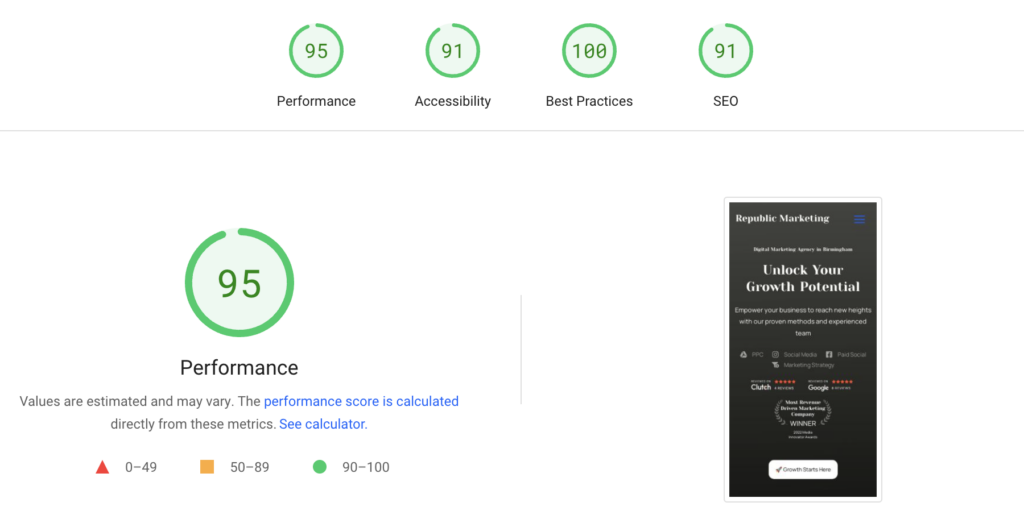
As we already mentioned, each of these components is appraised as “Above average,” “Average,” or “Below average” compared to other advertisers whose ads appeared for an identical keyword in the preceding 90 days. If any component lands an 'Average' or 'Below average' score, that's your cue to roll up your sleeves and optimise.
What is a good Quality Score for Google Ads?
The Quality Score is assessed on a scale that ranges from 1 to 10, where 1 signifies the lowest rank, while a score of 10 represents the highest. Generally, a good Quality Score in Google Ads is considered to be around 7 or above. However, it's important to remember that a 'good' score can vary depending on the industry, the competition and the specific keywords you're targeting.
How to optimise your Quality Score
If you’re interested in knowing How you can get a 10 out of 10 Quality Score on Google Ads, check out the guide below:
1-Nailing your Ad Relevance
Increasing ad relevance is crucial. Your ad should align seamlessly with the keywords in your ad groups. If your goal is to elevate Ad Relevance, consider these steps:
- Write an ad copy that resonates: Try to appeal to people's problems rather than just talking about your product's feature
- Formulate thoughtful keyword groupings: Build ad groups based on related keywords for a more focused approach.
- Leverage Dynamic Keyword Insertion (DKI): This neat feature allows you to dynamically place the keyword the user searches for into your ad copy, amplifying relevance.
- Experiment with headline pinning: Try creating two identical versions of your ad, one with headlines pinned and the other unpinned; see which one will do better!
2-Boost your landing page Experience
Optimising your landing page improves your quality score and increases the likelihood of conversions, making it a win-win endeavour. Remember, your landing page is often the first interaction a potential customer has with your brand, so making it as user-friendly and relevant as possible is key to a successful Google Ads strategy.
Your landing page should seamlessly extend your ad, meeting the user's search intent head-on. Here's how to elevate Landing Page Experience:
- Ensure landing page and ad copy are in sync with search intent: Present users with exactly what they're seeking.
- Be direct and succinct: Deploy easy-to-grasp headlines, subheadings, and body copy to communicate your value proposition and benefits.
- Boost page speed: Compressing images can significantly improve loading speed.
- Prioritise mobile responsiveness: Your landing page should adapt to varying screen sizes.
Incorporate a clear Call to Action (CTA): This must align with the ad copy and the user's search intent.
Finally, experiment with various landing page designs, a high bounce rate signal that users aren’t finding what they're searching for.
3-Improve Expected Click-Through Rate (CTR)
Expected CTR is a bit elusive when it comes to optimisation, as it's hinged on historical data that's not as straightforward as Ad Relevance or Landing Page Experience.
- Experiment with unique value propositions: Make your ads stand out by showcasing how your service or product helps users with their pain points.
- Be (Slightly) different: Don't just copy what everyone else is saying in their ads, try approach it from a different angle
- Test various and campaign-relevant ad assets: Ad extensions can furnish additional info and make your ad more tempting. Also don't just apply account-level links and extensions to all campaigns, try to tailor them to each campaign.
- Play around with different USPs and CTAs: Ensure they align with your landing page and pique your audience's curiosity.
- Harness psychological buying triggers: Infusing a sense of urgency, scarcity, or social proof can dramatically spike click-through rates.
In essence, optimising Expected CTR extends the optimisation of Ad Relevance, making your ad even more irresistible to potential customers.
👉 Make sure to check out our blog on PPC Management for SMEs
Also, if you're looking for an alternative to the Google Ads platform, we have a comprehensive guide on that topic and reviewed the top 10 viable alternatives.
4-Create theme-based campaign & ad group structure
Designing theme-based campaign structures and tightly knit ad groups assists Google in budget allocation and facilitates the creation of more granular and related ads for each ad group. This strategy ensures that your ads are relevant to search queries and will be displayed and triggered for the right intent. For those of you still thinking of doing SKAGs, well, I'm sorry to say that it wont work out!
For instance, consider a campaign focused on "DIY Website Design." This broad theme can be broken down into more specific ad groups based on various aspects of the overarching theme.
Ad Group 1: "Website Design Templates" Here, you might want to include keywords such as "Best DIY website templates" or "Easy website design templates."
Ad Group 2: "Website Design Tutorials" In this ad group, keywords like "DIY website design tutorials" or "Learn website design" could be effective.
Similarly, a campaign themed around "Digital Marketing" could be partitioned into different ad groups like:
Ad Group 1: "Digital Marketing Courses" For this ad group, keywords such as "Online digital marketing courses" or "Best marketing courses" would be relevant.
Ad Group 2: "Digital Marketing Tools" Here, you could use keywords like "Top digital marketing tools" or "Effective marketing tools."
You can improve Google's comprehension of the content and intent of your ads by maintaining a theme-based campaign and ad group structure. This will result in more relevant ad placements and possibly higher click-through rates. Your chances of a conversion increase because your ads are more likely to reach the target market for which they were created.
5-Use Automated Bidding Strategies
Google's automated bidding strategies improve your ad bidding process by utilising the strengths of machine learning and artificial intelligence. In terms of digital advertising, it has changed the game by streamlining the bidding process and improving ad performance.
In previous years, manual CPC (Cost Per Click) was often the starting point for many advertisers. However, by 2024, automated bidding strategies have evolved significantly, making it nearly impossible for manual strategies to compete. The sheer volume of real-time adjustments that automated bidding can perform far surpasses what a human could manage, leading to more efficient and effective bidding strategies.
Automated bidding uses multiple signals to fine-tune your ad delivery. These signals include the kind of device, the location, the day of the week, the time of day, the language, the operating system, and more. Automated bidding can determine when, to whom, and when your ads are shown, adjusting the display of your ads to help you more effectively reach your advertising objectives.
Moreover, automated bidding strategies can also factor in the complexities of auction-time bidding, considering billions of unique context signals within each auction. More precise optimisation is possible thanks to this level of specificity, increasing the likelihood that your ads will be seen by the right people at the right time.
In essence, adopting automated bidding strategies in 2024 is not just an option but a necessity for staying competitive in the dynamic landscape of digital advertising. It provides a more sophisticated, data-driven approach to ad bidding, ensuring your ads perform optimally and deliver the best possible return on investment.
6-Leverage Negative KWs lists and Negative KW sculpting
Incorporating negative keywords into your Google Ads strategy is a practical method to avoid unwanted impressions from unrelated search queries. This means your Click-Through Rate (CTR) can potentially improve, as you're already filtering out a significant portion of irrelevant traffic.
To implement this effectively, consider creating three layers of negative keywords. The first layer is at the account level, containing keywords for which you never want your ads to be displayed. This could include terms like "jobs," "loans," or "employment," which may not relate to your offering.
The second layer is at the campaign level, where you can add more detailed negative keywords that are specific to the campaign. This ensures that these negative keywords don't affect other campaigns. For instance, if you're running a campaign for 'leather shoes,' you might want to include 'vegan' as a negative keyword at the campaign level, as vegan shoppers wouldn't be interested in leather products. This wouldn't be necessary at the account level if you also sell vegan shoes in a different campaign.
Negative keyword sculpting, on the other hand, is a more refined approach. It's different from merely adding negative keywords, as it involves a strategic method of ensuring your ads don't get triggered by the wrong campaign or ad copy. Essentially, you add the targeted keywords of one campaign to the negative keyword list of another. This ensures each ad group or campaign is more focused and doesn't overlap with others.
While Google's algorithms have become increasingly efficient at matching ads to users and search terms, it doesn't hurt to guide the process by incorporating negative keyword sculpting into your strategy. This method can help in improving your Quality Score by making sure your ads reach the most relevant audience, thereby enhancing the effectiveness and efficiency of your campaigns.
Where can you find Quality Score in Google Ads?
Here are the steps to find the Quality Score (QS) in your Google Ads account:
- Sign in to your Google Ads account.
- Click on the 'Campaigns' tab at the top.
- Select the 'Keywords' tab.
- Look for the 'Quality Score' column in the keyword table.
If you don't see this column, you can add it by clicking on the 'Columns' button above the statistics table, then 'Modify columns', select 'Quality Score' and then click 'Apply'.
Conclusion
While Quality score seems to be an easy-to-understand topic, fixing low QS keywords could be time-consuming. You want to dedicate a certain number of hours each week to reviewing your QS score. You can also check out Google's default QS reporting tool that charts your KW's quality score over time. This can show you whether you are on the right path or not.
By applying what we discussed on improving Ad Relevance, Landing Page Experience, and Expected CTR, you can positively influence your Quality Score, thereby enhancing your ad performance and ROI.
How to optimise your Quality Score
1-Nailing your Ad Relevance
To enhance ad relevance, integrate keywords into your ad copy, create keyword-related ad groups, utilise Dynamic Keyword Insertion (DKI), and experiment with headline pinning. These steps can help optimise your ad and align it more effectively with your ad groups.
2-Boost your landing page Experience
Improving ad relevance involves inserting keywords into your ad copy, forming related ad groups, applying Dynamic Keyword Insertion (DKI), and testing headline pinning. These strategies align your ad with your groups, optimising effectiveness.
3-Improve Expected Click-Through Rate (CTR)
Enhancing Expected CTR, although reliant on historical data, is possible through highlighting unique propositions, tailoring ads to user intent, using ad assets like extensions, experimenting with various USPs and CTAs, and employing psychological buying triggers. These tactics not only optimise Ad Relevance but also make your ads more appealing to potential customers.
4-Create theme-based campaign & ad group structure
Creating theme-based campaigns and closely related ad groups facilitates Google's budget allocation, leads to more relevant ads, and enhances the likelihood of your ads reaching the intended audience
5-Use Automated Bidding Strategies
Leveraging Google's automated bidding strategies, which employ Machine Learning and AI, can outperform manual methods by considering multiple signals to optimise ad display, making it a necessity for efficient and effective digital advertising in 2024.
6-Leverage Negative KWs lists and Negative KW sculpting
Negative keywords lists and keyword sculpting can enhance your Google Ads strategy by preventing irrelevant impressions, structuring negative keywords at account and campaign levels, and ensuring ads don't get triggered by the wrong campaign, thereby improving your Quality Score.

